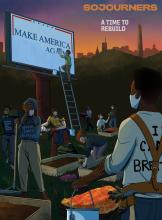WHAT IS REST and what does rest look like during a time of pandemic?
Over the past year, the multiple pandemics we have faced have upended many things, not least of which has been our language. “Essential” has been revealed to be simply another word for “disposable,” with “essential frontline workers” being those whose lives society deems expendable, not irreplaceable. “Safe” has been shown to be so shoddy, subjective, and circumscribed a reality in this country that protesting for Black lives in a pandemic is indeed safer than failing to protest at all. And “rest”—what is rest?
Many of us were struggling with healthy notions and practices of rest prior to COVID-19. Now? “Rest” seems both undefined and unattainable. Biblical images of rest have often been interpreted to emphasize separation, distance, and juxtaposition. For example, Jesus withdrawing from the crowds is often read as modeling rest distinct from the activity, the hubbub, the movement, the people. There is value in this reading of rest, particularly in how it spatially mediates self-care (thus, “retreats”). The thing about pandemics, however, lies in the pan- prefix denoting “all” or “every.” As safer-at-home policies and seemingly limitless racial violence make clear, whether facing COVID or white supremacy, withdrawal to elsewhere is not an option. So, what does rest mean when one cannot “retreat,” spatially or politically or otherwise?
Read the Full Article

